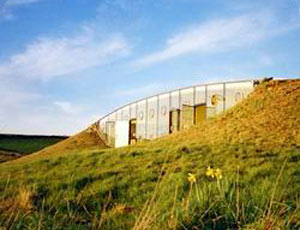As more and more people rebel against ticky-tacky, cookie-cutter homes, options are growing for more unique, satisfying dwellings.
Popular Mechanics' Chris Sweeney recently created a great list of 18 of the world's strangest homes. And though there are arguably some even stranger ones out there (the toilet-shaped home, for one, or the coral castle), one of the things we like about Popular Mechanics' list is a strong focus on sustainability.
The Popular Mechanics collection focuses on designs that think outside of the box and approach sustainability from a holistic perspective. Some include recycled materials, but recycling itself isn't usually the central theme.
You don't have to live in a house built out of discarded tires, bottles, or vehicles to "go green." There are many ways that we can all go green in our homes, no matter what they look like or where they are located. Switching to more efficient light bulbs and appliances, trying out energy monitoring devices, and boosting insulation are a few examples.
For the greenest of Popular Mechanics' strange houses, look below:

Photo: Courtesy of Free Spirit Spheres
Free Spirit Spheres
Looking like something from Star Wars, suspended tree houses known as Free Spirit Spheres excite the imagination. Made by Tom and Rosy Chudleigh from British Columbia, the "tree houses for adults" are handmade from local wood.
The spheres are recommended for meditation, photography, canopy research, leisure, wildlife watching and other activities, and they can be ordered fully loaded with plumbing, electricity and insulation. Some are available for rental, and DIY kits are offered. They reportedly sway in the wind.

Photo: www.arquitecturaorganica.com
The Nautilus House
Perhaps what Gaudi would have envisioned if he were asked to decorate a sea shell, the Nautilus in Mexico City was completed in 2006 by architect Javier Sensonian of Arquitectura Orgánica. Sensonian practices what he calls "bio-architecture," and has designed buildings shaped like snakes, whales and other living things.
The Nautilus was built for a young family who wanted something that felt more integrated with nature, and it isfilled with lush vegetation. The front door blends into the colorful mosaic facade.

Photo: RobertBruno.com
The Steel House
One glance at the fantastical Steel House, and you'll never forget it. Designer Robert Bruno wanted it to look somewhere between animal and machine, and we think he succeeded. The unique home is perched on a bluff near Lubbock, Texas, and minimizes disruption to the area by resting on top of four skinny legs.
Steel is long-lasting and highly recyclable, so green builders have been giving it a second look in recent years, especially for roofing. Inside, the Steel House looks more H.R. Giger than Martha Stewart, and it doesn't look like the most practical living space, but it definitely is thinking outside of the four-walled box.

Photo: dRRM Architects
The Sliding House
In a final form that quite closely resembles the the Barn House by Belgian architectural and planning firm BURO II (which reworks an existing barn), London-based dRRM Architects created the Sliding House in Suffolk, England.
This unique dwelling is designed to be flexible, allowing the owners to take advantage of fluctuations in light and temperature, maximizing energy savings through passive heating and cooling. The 20-ton outer shell can be retracted in six minutes, revealing an inner layer that's mostly glass. It's like layering up in clothing!

Photo: Gigaplex Architects
Montesilo
At Dancing Rabbit Ecovillage in Missouri, residents cobbled together a livable two-bedroom apartment from an old grain bin. Considerably more upscale is the attractive Montesilo in Woodland, Utah, finished in 2006 by Gigaplex Architects.
The Montesilo was made by joining together two corrugated grain silos, and it has a modest, space-efficient size of 1,800 square feet. The home sits in a gorgeous natural setting, near the Provo River, and the ample windows and balcony help bring the outdoors in.

Photo: Christian Patterson for Popular Mechanics
Amory Lovins' House
Leading green thinker Amory Lovins of the venerable Rocky Mountain Institute lives in a gorgeous home in Old Snowmass, Colorado, that costs a miserly $5 per month to power, thanks to passive solar design, 16-inch-thick walls, xenon-filled windows, and a pair of wood-burning stoves. The home is festooned with solar panels, and there's a passively controlled greenhouse that yields tropical fruit.
Begun in 1982, the house was way ahead of its time, and has recently been updated with LEDs, the latest energy-monitoring technology, and other green tweaks.

Photo: Future Systems
222 House
The remarkable 222 House in Wales leaves a nearly nonexistent footprint on the region's southwest coast. According to designers Future Systems, "The soft, organic form of the building is designed to melt into the rugged grass and gorse landscape, the roof and sides of the house being turfed with local vegetation."
Completed in 1994, the bathroom and kitchen are prefabricated pods that were lifted into the site during construction. The home needs little energy input due to the natural insulation of the ground.

Photo: Wikipedia Commons
Bubble Dream Castle
The space-age Bubble Dream Castle in southern France, near Cannes, was begun in 1975 by Antti Lovag.Inside, the livable sculpture resembles a set from vintage Star Trek, but with more light, since the windows are designed to take advantage of Mediterranean sun.
One of the goals of the visionary designer was to unify the home with its natural surrounding, by bringing outdoor elements inside. Today, the complex boasts 10 suites decorated by different artists, a reception hall seating 350, an outdoor auditorium, and a massive garden.

No comments:
Post a Comment